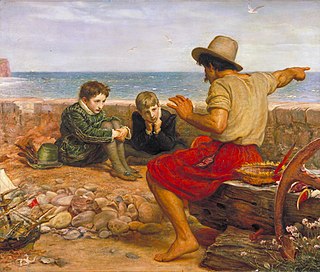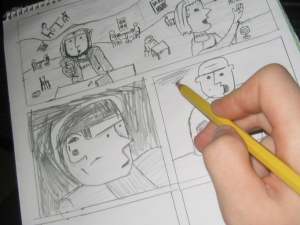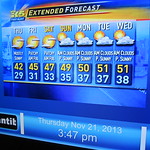Genre is any style or form of communication in any mode with socially agreed-upon conventions developed over time. In popular usage, it normally describes a category of literature, music, or other forms of art or entertainment, based on some set of stylistic criteria. Often, works fit into multiple genres by way of borrowing and recombining these conventions. Stand-alone texts, works, or pieces of communication may have individual styles, but genres are amalgams of these texts based on agreed-upon or socially inferred conventions. Some genres may have rigid, strictly adhered-to guidelines, while others may show great flexibility.

Storytelling is the social and cultural activity of sharing stories, sometimes with improvisation, theatrics or embellishment. Every culture has its own stories or narratives, which are shared as a means of entertainment, education, cultural preservation or instilling moral values. Crucial elements of stories and storytelling include plot, characters and narrative point of view. The term "storytelling" can refer specifically to oral storytelling but also broadly to techniques used in other media to unfold or disclose the narrative of a story.

In comics studies, sequential art is a term proposed by comics artist Will Eisner to describe art forms that use images deployed in a specific order for the purpose of graphic storytelling or conveying information. The best-known example of sequential art is comics.

A narrative, story, or tale is any account of a series of related events or experiences, whether nonfictional or fictional. Narratives can be presented through a sequence of written or spoken words, through still or moving images, or through any combination of these. The word derives from the Latin verb narrare, which is derived from the adjective gnarus. The formal and literary process of constructing a narrative—narration—is one of the four traditional rhetorical modes of discourse, along with argumentation, description, and exposition. This is a somewhat distinct usage from narration in the narrower sense of a commentary used to convey a story. Many additional narrative techniques, particularly literary ones, are used to build and enhance any given story.
Game studies, also known as ludology, is the study of games, the act of playing them, and the players and cultures surrounding them. It is a field of cultural studies that deals with all types of games throughout history. This field of research utilizes the tactics of, at least, folkloristics and cultural heritage, sociology and psychology, while examining aspects of the design of the game, the players in the game, and the role the game plays in its society or culture. Game studies is oftentimes confused with the study of video games, but this is only one area of focus; in reality game studies encompasses all types of gaming, including sports, board games, etc.
Gonzalo Frasca is a game designer and academic researcher focusing on serious and political videogames. His blog, Ludology.org, was cited by NBC News as a popular designation for academic researchers studying video games. For many years, Frasca also co-published Watercoolergames with Ian Bogost, a blog about serious games.
Interactive storytelling is a form of digital entertainment in which the storyline is not predetermined. The author creates the setting, characters, and situation which the narrative must address, but the user experiences a unique story based on their interactions with the story world. The architecture of an interactive storytelling program includes a drama manager, user model, and agent model to control, respectively, aspects of narrative production, player uniqueness, and character knowledge and behavior. Together, these systems generate characters that act "human," alter the world in real-time reactions to the player, and ensure that new narrative events unfold comprehensibly.
Narration is the use of a written or spoken commentary to convey a story to an audience. Narration is conveyed by a narrator: a specific person, or unspecified literary voice, developed by the creator of the story to deliver information to the audience, particularly about the plot: the series of events. Narration is a required element of all written stories, presenting the story in its entirety. It is optional in most other storytelling formats, such as films, plays, television shows and video games, in which the story can be conveyed through other means, like dialogue between characters or visual action.
Narratology is the study of narrative and narrative structure and the ways that these affect human perception. It is an anglicisation of French narratologie, coined by Tzvetan Todorov. Its theoretical lineage is traceable to Aristotle (Poetics) but modern narratology is agreed to have begun with the Russian formalists, particularly Vladimir Propp, and Mikhail Bakhtin's theories of heteroglossia, dialogism, and the chronotope first presented in The Dialogic Imagination (1975).
Digital storytelling is a short form of digital media production that allows everyday people to create and share their stories online. The method is frequently used in schools, museums, libraries, social work and health settings, and communities. They are thought to have educational, democratizing and even therapeutic effects.
Narrative journalism, also referred to as literary journalism, is defined as creative nonfiction that contains accurate, well-researched information. It is related to immersion journalism, where a writer follows a subject or theme for a long period of time and details an individual's experiences from a deeply personal perspective.
Jason Mittell is a professor of American studies and film and media culture at Middlebury College whose research interests include the history of television, media, culture, and new media. He is author of three books, Genre and Television (2004), Television and American Culture (2009), and Complex TV: The Poetics of Contemporary Television Storytelling, and co-editor of How To Watch Television.
Transmedia storytelling is the technique of telling a single story or story experience across multiple platforms and formats using current digital technologies.
In philosophy, lexis is a complete group of words in a language, vocabulary, the total set of all words in a language, and all words that have meaning or a function in grammar.

A film – also called a movie, motion picture, moving picture, picture, photoplay or (slang) flick – is a work of visual art that simulates experiences and otherwise communicates ideas, stories, perceptions, feelings, beauty, or atmosphere through the use of moving images. These images are generally accompanied by sound and, more rarely, other sensory stimulations. The word "cinema", short for cinematography, is often used to refer to filmmaking and the film industry, and the art form that is the result of it.
Narrative photography is the idea that photographs can be used to tell a story. Allen Feldman stated that "the event is not what happens. The event is that which can be narrated". Because photography captures single discrete moments, and narrative, as described by Jerome Bruner is irreducibly temporal, it might seem photography cannot actually represent narrative structure. Susan Sontag made this objection in her book, On Photography:

Multimodality is the application of multiple literacies within one medium. Multiple literacies or "modes" contribute to an audience's understanding of a composition. Everything from the placement of images to the organization of the content to the method of delivery creates meaning. This is the result of a shift from isolated text being relied on as the primary source of communication, to the image being utilized more frequently in the digital age. Multimodality describes communication practices in terms of the textual, aural, linguistic, spatial, and visual resources used to compose messages.

Maria Gertrudis "Mieke" Bal is a Dutch cultural theorist, video artist, and Professor Emerita in Literary Theory at the University of Amsterdam. Previously she also was Academy Professor of the Royal Netherlands Academy of Arts and Sciences and co-founder of the Amsterdam School for Cultural Analysis at the University of Amsterdam.
Transmediality is a term used in intermediality studies, narratology, and new media studies (in particular in the phrase ‘transmedia storytelling’ derived from Henry Jenkins, to describe phenomena which are non-media specific, meaning not connected to a specific medium, and can therefore be realized in a large number of different media, such as literature, art, film, or music. The medium from which a given phenomenon originated is either irrelevant or impossible to determine; it is not an adaptation of a phenomenon from one medium to another.
Julie Buffalohead is a contemporary Indigenous artist from the United States and member of Ponca Tribe of Indians of Oklahoma. Her work mainly focuses on themes of racial injustice, indigenous rights, and abuse of power. She creates paintings with stories told by anthropomorphic animal characters who have agency as individuals. Buffalohead conflates the mythical with the ordinary, the imaginary, and the real, and offers a space into which viewers can bring their own experiences.





